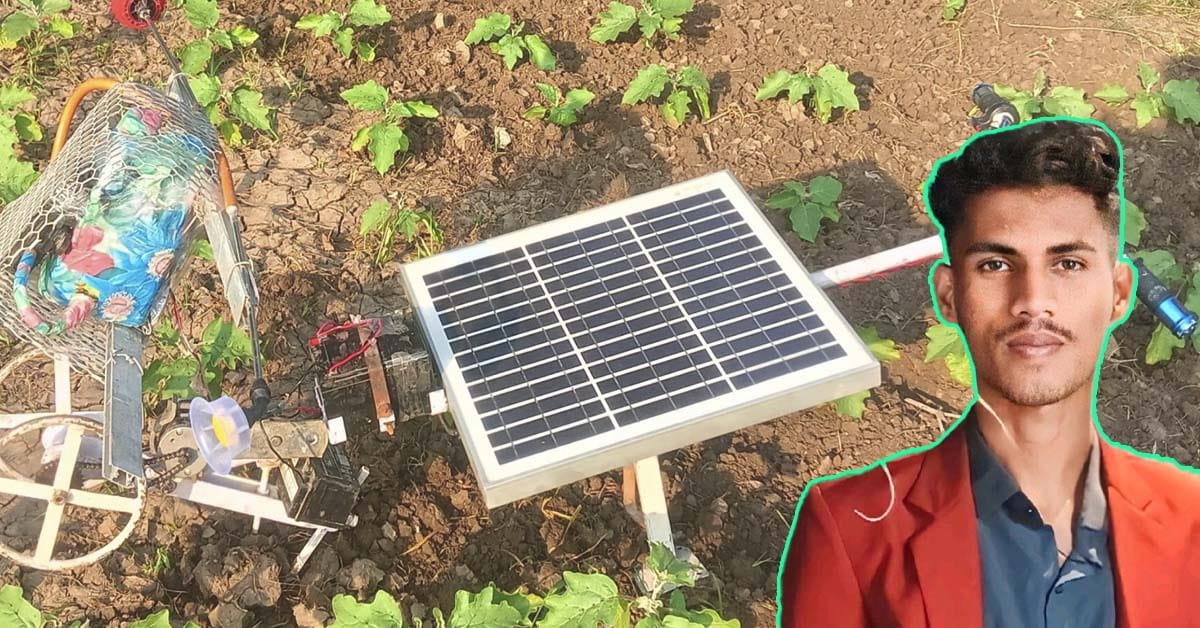Farmer’s Son Designs Solar Weed Killer To Ease Backbreaking Manual Work on Fields
There are four critical farming operations -- weeding, drilling seeds, spraying fertiliser and laying manure -- all taken care of by 18-year-old Ramdhan Lodha's solar powered machine.

Ramdhan Lodha grew up amidst the sunny fields of Jhalawar in Rajasthan. The 18-year-old was acutely aware of the challenges faced by farmers as he saw his parents toil in the fields for a meagre income.
As a young boy, a keen interest in science led Ramdhan to spend most of his time tinkering with machines and experiments. He participated in every science competition announced at the school with the mindset of creating something new. While the innovations were small in the beginning, a problem he observed at home left him with a burning desire to solve it.
He saw his father, Rajaram Lodha, spending hours at the field, lugging around a heavy spray pump on his shoulder to spray fertilisers on the crops. With age, this task became increasingly difficult and tedious for his father. Continuous usage also caused injuries on his shoulder, which pained young Ramdhan.
The young innovator decided to solve this problem for his father by building a machine that would spray fertiliser and uproot weeds at the same time. While the idea was great, funding was a challenge as Ramdhan didn’t want to burden his parents.
Starting almost three years ago, he participated in competitions to earn the money for his innovation. With the prize money received, he has successfully built a solar-powered weed killing machine today, which is a multifaceted agricultural tool that significantly reduces the physical strain on farmers and is eco-friendly.
Besides this achievement, he recently received Rs 1 lakh as prize money at the Indian Silicon Valley challenge, a nationwide competition hosted by the Scaler school of technology.
Here’s how Ramdhan built this innovation:
A ray of hope for small farmers
Ramdhan, who recently passed Class 12, had a keen eye on solving agricultural problems through science and technology. He saw the hardships faced by the farmers in Jhalawar – where a majority of them own less than five acres of land.

Right from weed removal to spraying fertilisers, these farmers had two options, rent expensive machines that save time, or hire labourers to do the work causing a significant dent in their already low income.
As the teenager looked for solutions, he remembered seeing his grandfather using a manual machine to remove weeds.
Could he modify it by making it electric and add multiple options using technology?
“Most of the farmers around me, including my father, used to rent tractors and other machines to sow seeds and remove weeds. The other option was to hire labourers for 10-12 days. Both options caused a lot of expense to farmers,” shares Ramdhan with The Better India.
At the age of 15, he sketched the first prototype of this machine and submitted the entry at the government’s INSPIRE Award – MANAK (Million Minds Augmenting National Aspiration and Knowledge). He won the award and received a prize money of Rs 10,000, which he used to build his first prototype.
“I wanted to build a machine that would do multiple tasks. I wanted to prevent farmers from lugging around 10 litre spray pumps on their shoulders, which you have to refill from time to time,” he adds.
He took his sketch, some old cycles and went to a welder who helped him make the machine. His first prototype was a machine which could sow seeds and spray pesticides. Ramdhan laughs as he shares that his machine is a product of jugaad (hack).
Testing the machine was easy as his father became the guinea pig. Seeing the practicality of it, farmers from nearby also borrowed it, validating the teenager’s efforts.
“The farmers liked it and even though they had to manually push it, it was better than renting machines. I wanted to improve it further as I saw that it was helping them practically,” he shares.
Subsequent prize money won at national science fairs helped Ramdhan add a motor, batteries and solar panel, making it electric. Started when he was in Class 10, he had made his final and third prototype by the time he was in Class 12. The entire machine was built at a cost of Rs 30,000.
How the machine works
The machine is in essence, a modified cycle, with a battery, solar panel, spray pumps on both sides and a weed remover in the front.
The multi-tasking machine can perform four critical farming operations – cleaning weeds, drilling seeds, spraying fertiliser and laying manure. It works on both solar power and has a battery, for cloudy days.
It can be customised for length and folded for easy transportation. The design incorporates easily adjustable parts and attachments that mimic the functionality of larger, more expensive farming machinery, making it an ideal solution for small-scale farmers.
“It can do all these different tasks at the same time, saving time and energy. You can remove weeds and spray fertilisers at the same time. It eliminates the need for picking up heavy spray tanks and hiring labourers,” adds Ramdhan.
It also comes with a bulb for farmers who wish to work at night and has a charger for the battery.
Ramdhan’s father beams with pride as he speaks about his son’s innovation.
“It made life so much easier for me. All manual tasks which would take time can now be done at a press of a button,” he shares.
The latest prize money at the Indian Silicon Valley Challenge is a shot in the arm for Ramdhan, as he aims to get his machine market ready.
Even as most people in his village aim for a government job, Ramdhan is firm on becoming an entrepreneur and making his practical and cost-effective machine available to small-scale farmers across the country.
With his family’s support clearly behind him, Ramdhan continues to refine his invention and dreams of wider adoption across farms in India.
“I want to make the lives of small farmers across the country less laborious and more profitable,” he concludes.
Edited by Padmashree Pande, Images Courtesy Ramdhan Lodha
If you found our stories insightful, informative, or even just enjoyable, we invite you to consider making a voluntary payment to support the work we do at The Better India. Your contribution helps us continue producing quality content that educates, inspires, and drives positive change.
Choose one of the payment options below for your contribution-
By paying for the stories you value, you directly contribute to sustaining our efforts focused on making a difference in the world. Together, let's ensure that impactful stories continue to be told and shared, enriching lives and communities alike.
Thank you for your support. Here are some frequently asked questions you might find helpful to know why you are contributing?

















Check what other members are talking about -
Hello pls kindly send the better India Mumbai office contact no
Where can I get this solar reflective white paint for rooftop application in Mumbai?
Where can I buy the grow bags made by Eyyo ?